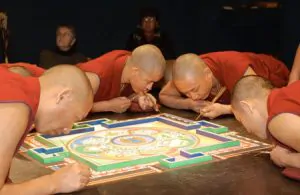Meditation in Recovery: Traditional and Alternative Methods
The Power of Meditation in Recovery
The busy lifestyle and constant pace of American culture has taken its toll on many Americans. Every day worries, for many, include early mornings after late nights. For many rush hour traffic on the way to work and on the way back. Sometimes, it is office politics and family matters. Endless gas pumps and mortgage payments. Stress affects our physical and mental health and well-being. Luckily, there is an easy and effective way to reduce the damaging effects of stress. An easy way to find that inner calm so many of us want.
The Practice of Meditation
The practice of meditation comes from the Eastern philosophy of healing and health. Mindful meditation is based on the belief that the mind and body must be in harmony. Maintaining a positive “Qi”, (pronounced chi) translated as “energy flow”. It has taken a little longer for the holistic concept of meditation to be popular in America. Here health is promised in capsules and milligrams. It is not that American doctors only want to write prescriptions. Rather, their Western medical training relies heavily on empirical proof from countless research studies.
Over the last twenty years, researchers have studied the effectiveness of Eastern methods of healing. Especially meditation. The results have concluded that meditation and mindfulness improves physical and psychological health. The same issues that have formerly been treated with prescription and OTC medications, including:
Physical Health
- Anxiety and sleep disorders
- Asthma
- Depression
- Heart disease
- High blood pressure
- Pain
Emotional/Psychological Health
- It can increase introspection skills
- Increases stress-management skills
- It increases self-awareness
- Increases ability to focus
- Reducing negative emotions
- Increases memory and cognitive functions
- Reduces rigid-thinking
What is Mindful Breathing?
Mindful breathing is a simplified form of meditation. It can be done any place, any time, by anyone seeking to reduce feelings of stress and anxiety. Many people have a difficult time with the concept of mindful meditation. Often because they believe it requires one to achieve a quiet mind. A quiet mind is a wonderful thought. However, it is an impossible goal. The human mind is always on. Always processing information, problem solving, and randomly thinking. The true objective of mindful meditation is finding a focal point. Then training the mind to stay on that focal point for a given amount of time. This is why mindful breathing is meditation, just simplified.
The focal point of mindful breathing is the breathing rhythm. The tiny space between the inhale and the exhale. Inhaling through your nose, you exhale through your mouth. Some people touch the tip of their tongue to the roof of their mouth, as done in Reiki yoga. Like all forms of meditation, mindful breathing takes practice. It may come more naturally to some than to others. There are no “rules” to follow or break.
Here are some things to remember when beginning mindful breathing:
Thoughts Will Come and Thoughts Will Go
With practice, thoughts will come flowing in. In time, rest somewhere in the back of your consciousness. Your brain is an organic machine. It is always processing. Imagine your thoughts as white noise. You will find yourself able to recognize them without focusing on them. Some people use imagery to manage thoughts during meditation. During mindful breathing, you can just return your focus on your breathing. Imagine your breath as colors. One color on the inhale blending into another color on the exhale. If you are in a cold environment, focus on the feeling of the cold air coming into your nose. The chill in the back of your throat. The hot air as it passes out of your mouth. Whenever your thoughts wonder away from your breaths, just let them go and return to breathing and counting.
Breathe Naturally or Rhythmically
You can breathe naturally or in a rhythm. Some guided breathing meditations use different rhythms for different meditation goals. For example, a positive affirmation meditation may have a choreographed breathing rhythm. 3-count inhale and a 4-count exhale (4-0-3 Affirmation Meditation). A popular new breathing meditation for insomnia has a choreographed breathing rhythm. 4-count inhale, 7-count hold, 8-count exhale (4-7-8 Insomnia Meditation).
Relaxation is the Purpose of Mindful Breathing
Mindfulness is not always a relaxing moment. Its most effective when used to cope with stressful situations. It is also a recommended strategy for people recovering from addiction when struggling with cravings. You may feel less stressed after a mindful meditation. But, that is not the goal. The goal of mindfulness is to step away from negative thoughts and self-talk. Those are a constant occurrence for many people in today’s fast-paced, high-stress environment. For people struggling with anxiety attacks, mindful breathing is often done with affirmations. Said aloud or quietly, “I am safe, I am OK”. Mindfulness reacquaints the body and mind to the present moment.
To Start
To introduce mindfulness breathing in your daily routine, start easy; begin with 3-5 minute meditations or 8-10 breath cycles. Try making it a routine first thing in the morning, during a lunch break, or right before bed. There are also many resources to help you with your mindfulness exercises. YouTube has guided breathing meditations for almost every mood and situation. There are also apps that can guide mindfulness breathing. Try setting an alarm, on your phone, to remind you to take a mindful moment out of your day. Just…breathe.
Alternative Meditation Practice: Mandala Coloring
There are those who aren’t as comfortable with the stillness of traditional meditation methods. An alternative that has grown in popularity in recent years is adult coloring. Particularly, coloring complicated images known as Mandalas.
Most people assume they need to have artistic talent or skill to gain any emotional or psychological benefit from art. But that is not true. A very easy-to-learn art meditation is adult coloring with geometric shapes known as mandalas. Mandala art has a long history of use by Tibetan monks and Native Americans as a form of meditation (Violatti, 2013).
Buddhist Mandalas:
Mandalas are created by the Buddhist monks of Tibet. They use brightly colored, ultra-fine sand, gently funneled into a complex geometric pattern. They often represent the Universe, in its ideal form. The process begins with a religious ceremony. During the ceremony a site for the mandala is chosen and the shape created. Then, over a 10-day period, the monks color the shape slowly, using metal funnels. After it is completed, the monks dismantle the mandala to represent the impermanence of all that exists. They disperse the sand to symbolize the blessings of the Universe (Blume, 2015).
Coloring the Mandala
There’s not much technique needed. Here are a few suggestions to get the most meditative benefits from mandala coloring:
- Find a quiet place, free of distractions
- Set aside a good space of time, it takes a few minutes to reach a concentrative stage
- Make sure you have all the materials you want close at hand, to minimize breaks in concentration
The more complex and detailed patterns require extra concentration, effort, and patience. All techniques used in traditional meditation. For an extra challenge, try attributing an emotion or thought to the design. Perhaps repeat a word or mantra while coloring the mandala.
Where to Find Mandalas
Mandala patterns are easy to find online. Simply download and print. Ones that are more complex can be found in bookstores and Amazon. Some books include meditation guides and explanations of each pattern. If you are extra artistic, you can try drawing your own mandala. Make it represent a thought or mood. The possibilities are endless. Just remember to keep it stress-free and relaxing.



